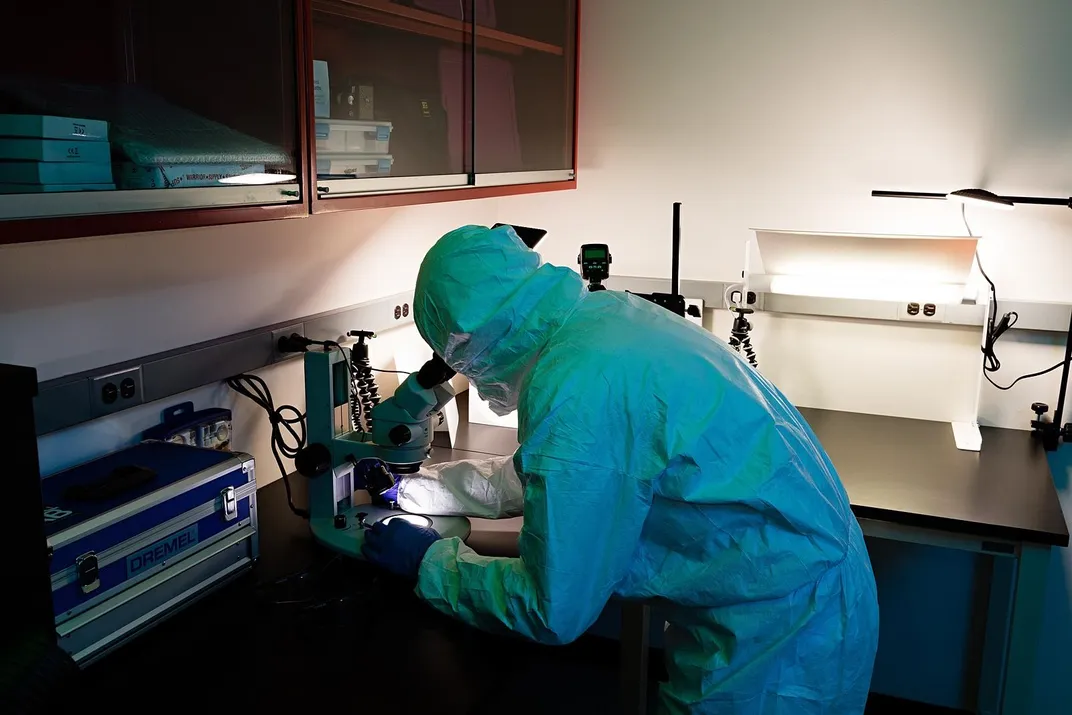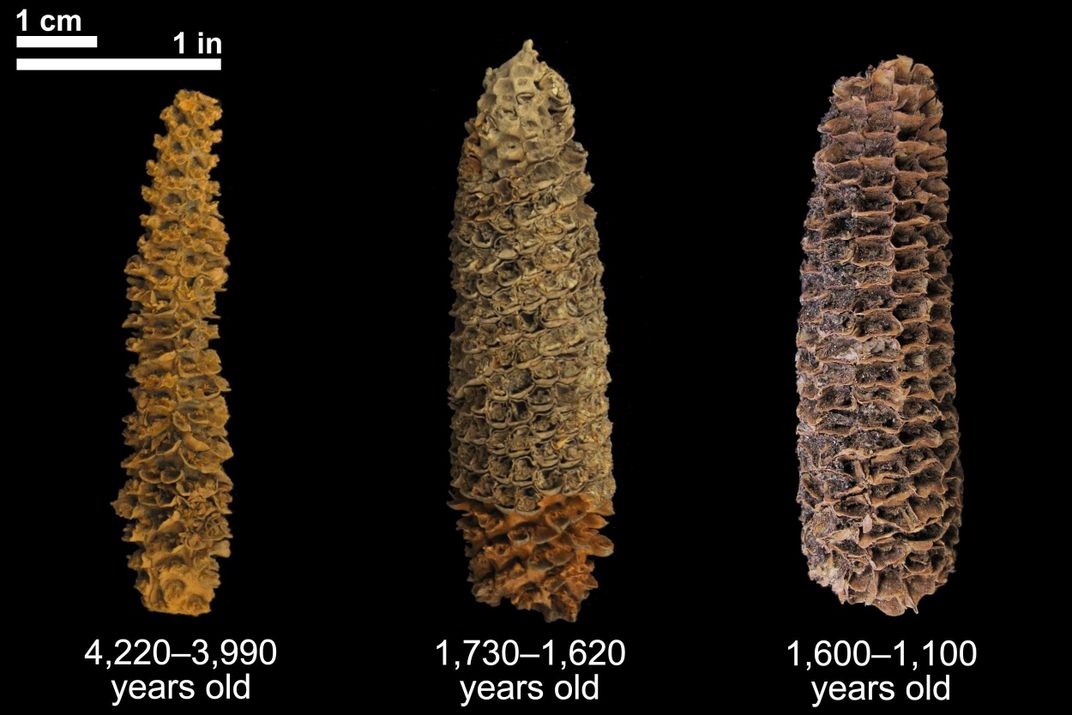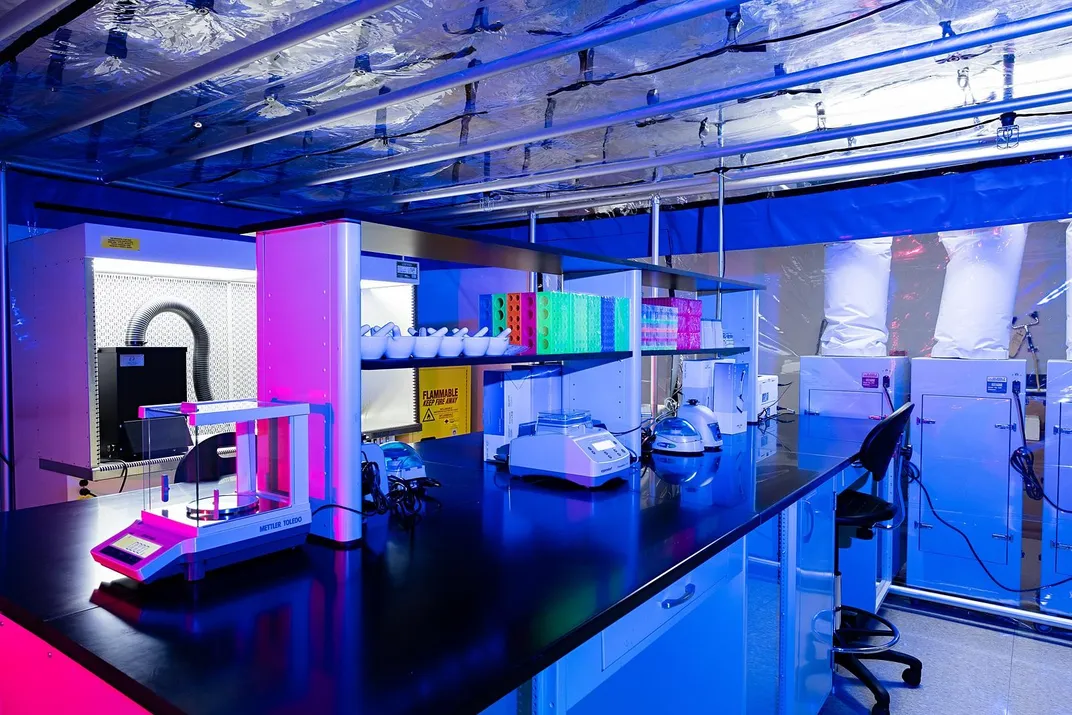NATIONAL MUSEUM OF NATURAL HISTORY
How Ancient DNA Unearths Corn’s A-maize-ing History
New study shows how extracting whole genomes from ancient material opens the door for new research questions and breathes new life into old samples.
/https://tf-cmsv2-smithsonianmag-media.s3.amazonaws.com/blogging/featured/Five_old_corn_cobs_on_a_black_background..jpg)
In the early 2000s, archeologists began excavating a rock shelter in the highlands of southwestern Honduras that stored thousands of maize cobs and other plant remains from up to 11,000 years ago. Scientists use these dried plants to learn about the diets, land-use and trading patterns of ancient communities.
After years of excavations, radiocarbon dating and more traditional archaeological studies, researchers are now turning to ancient DNA to provide more detail to their insights than has ever before been possible.
In a paper published today in the Proceedings of the National Academy of Sciences, scientists used DNA from 2,000-year-old corn cobs to reveal that people reintroduced improved varieties of domesticated maize into Central America from South America thousands of years ago. Archeologists knew that domesticated maize traveled south, but these genomes provide the first evidence of the trade moving both directions.
Researchers at the Smithsonian and around the world are just beginning to tap into the potential of ancient DNA. This study shows how the relatively recent ability to extract whole genomes from ancient material opens the door for new types of research questions and breathes new life into old samples, whether from fieldwork or forgotten corners of museum collections.
Cobbling together DNA
DNA, packed tightly into each of our cells, holds the code for life. The complex molecule is shaped like a twisting ladder. Each rung is made up of two complementary molecules, called a base pair. As humans, we have around three billion base pairs that make up our DNA. The order of these base pairs determines our genes, and the DNA sequence in its entirety, with all the molecules in the correct position, is called a genome. Whole genomes provide scientists with detailed data about organisms, but the process of acquiring that information is time sensitive.
“In every cell, DNA is always being bombarded with chemical and physical damage,” said lead author Logan Kistler, curator of archeobotany and acheogenomics at the Smithsonian’s National Museum of Natural History. “In live cells, it’s easily repaired. But after an organism dies, those processes that patch things up stop functioning.” As a result, DNA begins breaking down into smaller and smaller fragments until it disappears entirely. This decomposition poses the greatest challenge for scientists trying to sequence entire genomes from old or poorly-preserved tissue.

“You have to take these really, really small pieces of DNA — the length of the alphabet in some cases – and try to stitch them back together to make even a 1000 piece long fragment,” said Melissa Hawkins, a curator of mammals at the Smithsonian who works with ancient DNA. “It’s like trying to put a book back together by having five words at a time and trying to find where those words overlap.”
This laborious process prevented researchers from sequencing whole genomes from ancient DNA until around 2008, when a new way to sequence DNA became available. Since then, the technology and the ability to reconstruct ancient DNA sequences has grown rapidly.
Ancient DNA still proves challenging to work with, however. Kistler and colleagues collected 30 maize cobs from the thousands in the El Gigante rock shelter in Honduras. The material ranged in age from around 2,000 to around 4,000 years old. Of the 30 cobs that the researchers tried to extract DNA from, only three of the 2,000-year-old samples provided enough to stitch together whole genomes. A few others provided shorter snippets of DNA, but most of the cobs didn’t have any usable genetic material left after thousands of years.
The second biggest problem researchers face when working with ancient DNA is contamination. “Everything living is a DNA factory,” said Kistler. When working with samples that are thousands of years old, the researchers take extra precautions to avoid mixing modern DNA into their samples. They don sterilized suits and work in an air-tight, positive-pressure lab designed specifically for working with ancient DNA.
A-maize-ing possibilities
The ability to sequence whole genomes from thousands of years ago has allowed researchers to ask questions they couldn’t think of answering using individual genes or smaller DNA fragments.
“A whole genome is comprised of several hundred ancestral genomes, so it’s sort of a time capsule of the entire population,” said Kistler. For important staple crops like maize, this means researchers can study the genes associated with domestication and determine when and how people changed it over time. And knowing what communities were doing with crops provides insight into other parts of life, such as land-use and trading.
“Whole genome sequencing of ancient materials is revolutionizing our understanding of the past,” said co-lead author Douglas Kennett from the University of California, Santa Barbara. The authors dug into the whole genome for information about how maize domestication occurred and where it spread.

Before their results, it was widely assumed that maize was mostly flowing southward. They were surprised to learn that improved maize varieties were also reintroduced northward from South America. “We could only know this through whole genome sequencing,” said Kennett. Next, the scientists plan to pinpoint more specific dates for the movement of maize and connect its history to broader societal changes in the pre-colonial Americas.
Growing applications
The same technological advances that made Kistler and Kennett’s maize study possible have also created new uses for museum specimens. Scientists use ancient genomes to study how humans influenced plant and animal population sizes over time, species diversity and how closely related organisms are to each other. They even expect to discover new species hiding in plain sight.
“Sometimes, species are really hard to tell apart just by looking at them,” said Hawkins. “There is so much more that we don’t know.” To make extracting and sequencing DNA from older museum specimens easier, the Smithsonian is in the process of building a historic DNA lab. This space, separate from the ancient DNA lab, will allow researchers to focus on older collections with tissue quality that falls between ancient samples from archeological sites and freshly frozen material.

“It’s really amazing that we have the opportunity to learn from samples that have already been here for 100 years,” said Hawkins. “We’ve unlocked all these museum collections, and we can do so many more things with them now than anyone had a clue was possible even 15 years ago.”
Related stories:
Our Thanksgiving Menu has Lost a Few Crops
Scientists to Read DNA of All Eukaryotes in 10 Years
Safety Suit Up: New Clean Room Allows Scientists to Study Fragile Ancient DNA

